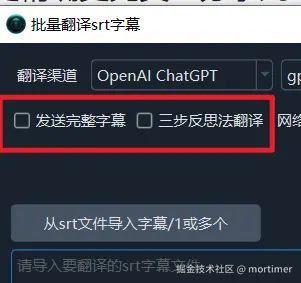现在AI越来越厉害,价格也越来越亲民,用AI来翻译字幕,比传统的百度翻译、Google翻译又快又便宜!翻译效果好不好,除了看AI模型本身够不够“聪明”,关键还得看你给它的“指令”(也就是提示词)写得怎么样。
虽然视频翻译软件里会有一些自带的“指令”,但你完全可以根据自己的经验来改,效果肯定更好!这篇文章就来聊聊AI翻译是怎么回事,用的时候要注意些什么,还会分享几个好用的“指令”给大家参考。
在视频翻译软件中,AI翻译提示词有3种类型,分别是:

不发送完整字幕
启用方法:软件中取消选中 发送完整字幕
即仅仅将字幕中的文本行发给AI进行翻译,不发送行号、时间行、空行
优点: 节省token,降低API调用费率
缺点: 严格要求译文行数等于原文行数,但由于不同语言语法和语序差异,译文可能会出现合并,导致译文出现一些空白行。
例如原文10行,期望翻译结果也是10行,但实际结果可能是8行或9行,因为不同语言语法、语序差异,AI可能将相邻两行原文翻译为一行译文,导致最后出现空白行。
示例原文2行内容
星期六时, 我们去吃火锅吧.期望翻译结果也是两行,然而AI很可能将之翻译为一行,如下
Let's go for hot pot on Saturday [这是空白行]即便通过提示词强行要求行对应,AI也未必严格遵循。
发送完整字幕
启用方法:软件中选中 发送完整字幕
将完整的字幕内容,包括行号、时间行、字幕文本、空行一起发给AI进行翻译
优点: 可大幅减少上述空白行出现的几率。
缺点:
- 无法彻底杜绝空白行的出现。
- 行号和时间行并不需要翻译,但仍然需发送和返回,浪费token,增加AI费用。
如何尽量提升翻译质量:
- 使用更先进、更新的模型,例如
Deepseek-r1、chatgpt-o3、qwen2.5-max等 - 选中
发送完整字幕 - 如果使用的是有思维链的模型,例如
deepseek-r1/o3,将发送字幕行数降低,防止输出token过多被截断,从而报错。在菜单--工具/高级选项--高级选项--AI翻译每次发送字幕行数中设置数量,如下。

提示词txt末尾带
-en.txt的文件是当软件界面为英文时,使用的提示词。例如chagpt-en.txt
